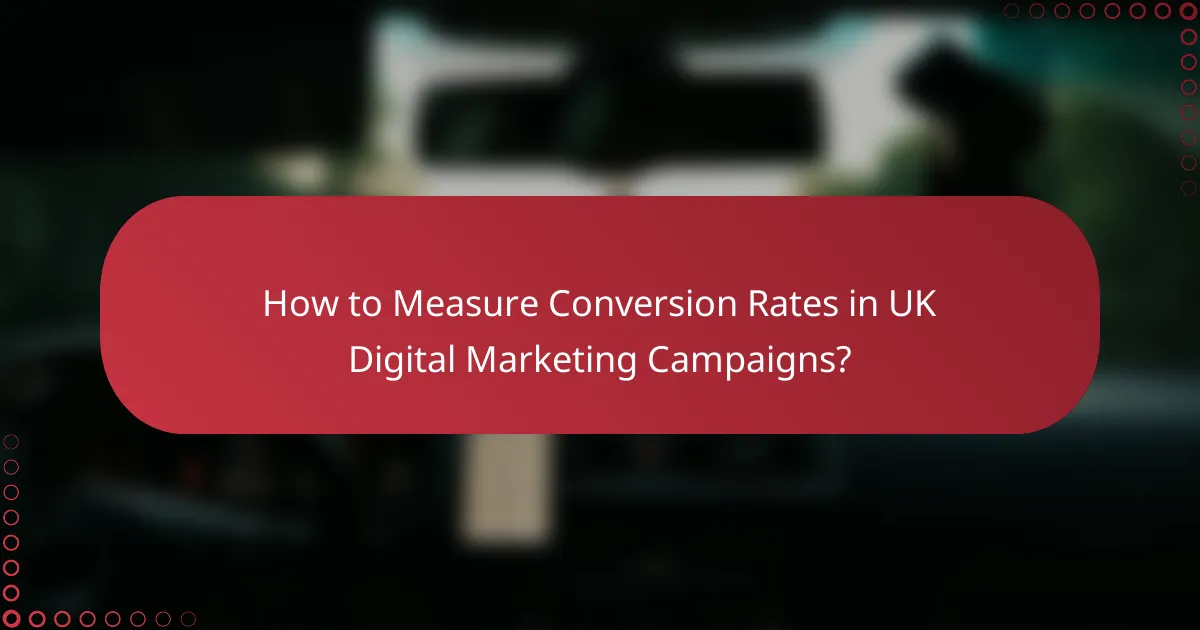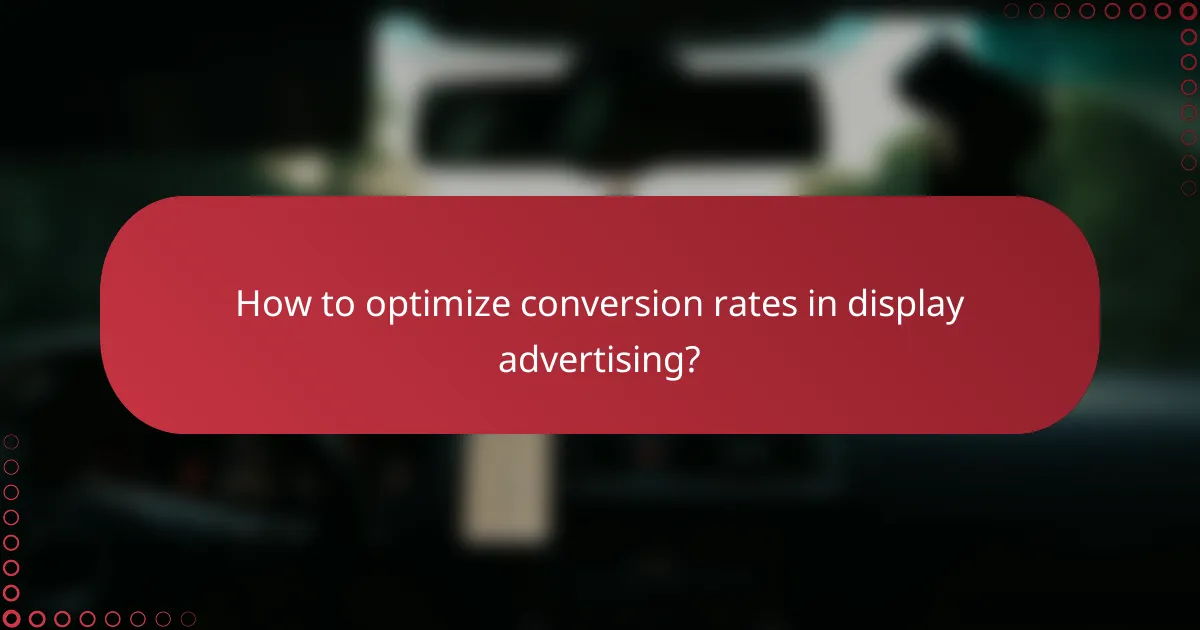Measuring conversion rates in UK digital marketing campaigns is essential for understanding user engagement and the effectiveness of marketing efforts. By tracking specific actions, such as purchases or sign-ups, relative to total visitors, marketers can optimize their strategies for improved performance. Utilizing key metrics like click-through rate (CTR) and cost per acquisition (CPA) further enhances this evaluation process.

How to Measure Conversion Rates in UK Digital Marketing Campaigns?
Measuring conversion rates in UK digital marketing campaigns involves tracking specific actions taken by users, such as purchases or sign-ups, relative to the total number of visitors. This metric helps assess the effectiveness of marketing strategies and optimize campaigns for better performance.
Utilize Google Analytics for tracking
Google Analytics is a powerful tool for measuring conversion rates. By setting up goals within the platform, you can track user actions that matter most, such as completing a purchase or filling out a contact form. Ensure that you configure your goals accurately to reflect the specific conversions you want to monitor.
Regularly review the data provided by Google Analytics to identify trends and patterns in user behavior. This can help you understand which marketing channels are driving the most conversions and where to allocate your budget for maximum impact.
Implement conversion tracking pixels
Conversion tracking pixels are snippets of code placed on your website to monitor user actions. By integrating these pixels from platforms like Facebook or Google Ads, you can gather data on how effective your ads are in driving conversions. This method allows for precise tracking of user interactions post-click.
When using conversion tracking pixels, ensure they are correctly implemented on the relevant pages, such as thank-you or confirmation pages. Regularly check for any discrepancies in tracking to maintain accurate data collection.
Analyze A/B testing results
A/B testing involves comparing two versions of a webpage or ad to determine which performs better in terms of conversion rates. By systematically testing different elements, such as headlines, images, or calls to action, you can identify what resonates best with your audience.
To conduct effective A/B tests, ensure you have a sufficient sample size to achieve statistically significant results. Analyze the outcomes to make informed decisions about your marketing strategies, focusing on the variations that yield the highest conversion rates.

What are the key metrics for conversion rates?
The key metrics for measuring conversion rates in UK digital marketing campaigns include click-through rate (CTR), cost per acquisition (CPA), and return on ad spend (ROAS). Understanding these metrics helps marketers evaluate the effectiveness of their campaigns and optimize for better performance.
Click-through rate (CTR)
Click-through rate (CTR) is the percentage of users who click on an ad compared to the total number of users who view it. A higher CTR indicates that the ad is engaging and relevant to the audience. For UK campaigns, a CTR of 2-5% is often considered average, while anything above 5% is typically viewed as strong.
To improve CTR, focus on creating compelling ad copy and using eye-catching visuals. A/B testing different headlines and calls to action can also help identify what resonates best with your audience.
Cost per acquisition (CPA)
Cost per acquisition (CPA) measures the total cost of acquiring a customer through a specific campaign. This metric is crucial for understanding the efficiency of your marketing spend. In the UK, a CPA can vary widely depending on the industry, with averages ranging from £30 to £100.
To manage CPA effectively, set clear budget limits and monitor performance regularly. If CPA exceeds your target, consider adjusting your targeting or optimizing your ad creatives to improve conversion rates.
Return on ad spend (ROAS)
Return on ad spend (ROAS) calculates the revenue generated for every pound spent on advertising. A ROAS of 4:1 is often considered a good benchmark, meaning for every £1 spent, £4 in revenue is generated. This metric helps assess the profitability of your campaigns.
To enhance ROAS, focus on targeting the right audience and refining your ad placements. Regularly analyze which channels yield the highest returns and allocate more budget to those areas while reducing spend on underperforming campaigns.

What tools can enhance conversion rate measurement?
Several tools can significantly improve the measurement of conversion rates in digital marketing campaigns. These tools provide insights into user behavior, facilitate A/B testing, and integrate customer relationship management (CRM) systems, helping marketers make data-driven decisions.
Optimizely for A/B testing
Optimizely is a powerful platform for A/B testing, allowing marketers to compare different versions of web pages to determine which performs better in terms of conversion rates. Users can easily set up experiments and analyze results in real-time, making it straightforward to implement changes based on data.
When using Optimizely, consider testing one variable at a time for clearer insights. Common elements to test include headlines, call-to-action buttons, and images. Aim for a sample size that provides statistically significant results, typically in the low hundreds or thousands, depending on your traffic levels.
Hotjar for user behavior insights
Hotjar offers tools like heatmaps and session recordings to visualize user interactions on your website. By understanding how visitors navigate your site, you can identify areas that may be causing friction and impacting conversion rates.
Utilize Hotjar’s feedback polls and surveys to gather direct input from users about their experience. This qualitative data can complement quantitative metrics, helping you make informed adjustments to enhance user experience and boost conversions.
HubSpot for CRM integration
HubSpot provides a comprehensive CRM solution that integrates seamlessly with marketing efforts, allowing for better tracking of customer interactions and conversion rates. By centralizing data, marketers can analyze customer journeys and identify which touchpoints are most effective in driving conversions.
To maximize HubSpot’s capabilities, ensure that your marketing and sales teams are aligned in using the platform. Regularly review analytics to refine your strategies and focus on high-impact areas, such as lead nurturing and follow-up communications.

What factors influence conversion rates in the UK?
Several factors significantly influence conversion rates in UK digital marketing campaigns, including website design, audience targeting, and the effectiveness of ad copy. Understanding these elements can help marketers optimize their strategies to improve conversions.
Website design and user experience
Website design and user experience (UX) play a crucial role in determining conversion rates. A well-structured site that is visually appealing and easy to navigate can lead to higher engagement and conversions. Key aspects to consider include page load speed, mobile responsiveness, and intuitive navigation.
For instance, a website that loads in under three seconds is likely to retain more visitors compared to one that takes longer. Ensure that call-to-action buttons are prominent and that the overall design aligns with the brand’s identity to foster trust and encourage action.
Target audience segmentation
Effective target audience segmentation is essential for maximizing conversion rates. By dividing the audience into specific groups based on demographics, interests, and behaviors, marketers can tailor their messages to resonate more deeply with each segment. This personalized approach increases the likelihood of conversions.
Consider using tools like Google Analytics to gather data on user behavior and preferences. Create targeted campaigns that address the unique needs of each segment, which can lead to improved engagement and higher conversion rates.
Ad copy and creative effectiveness
The effectiveness of ad copy and creative elements directly impacts conversion rates. Compelling headlines, clear messaging, and strong calls to action can significantly enhance the appeal of an advertisement. It’s important to focus on the benefits of the product or service rather than just the features.
Testing different versions of ad copy through A/B testing can provide insights into what resonates best with the audience. Aim for clarity and emotional appeal in your messaging to drive conversions, and ensure that the creative elements are consistent with the overall campaign theme.

How to optimize conversion rates in display advertising?
To optimize conversion rates in display advertising, focus on precise audience targeting and compelling ad creatives. These elements significantly influence how effectively your ads convert viewers into customers.
Refine audience targeting strategies
Effective audience targeting is crucial for maximizing conversion rates in display advertising. Utilize data analytics to segment your audience based on demographics, interests, and online behavior. This allows you to tailor your ads to specific groups, increasing relevance and engagement.
Consider using tools like Google Ads or Facebook Ads Manager, which offer robust targeting options. Aim for a balance between broad and niche targeting; overly broad campaigns may waste budget, while too narrow targeting might limit reach.
Enhance ad creatives and messaging
High-quality ad creatives and clear messaging can significantly boost conversion rates. Ensure your visuals are eye-catching and your copy is concise, highlighting key benefits and calls to action. Test different formats, such as static images, videos, or interactive ads, to see what resonates best with your audience.
Regularly A/B test your ads to identify which elements perform better. For instance, varying headlines or images can provide insights into what drives engagement. Keep your messaging consistent with your brand voice while adapting it to fit the specific audience segment you are targeting.



